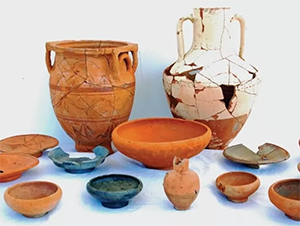|
Egyptian Battle Dig Site Tied to Rosetta Stone
February 6, 2023
Archaeologists have connected the dots from a long-running Egyptian dig to the Rosetta Stone. The dig is Tell el-Timai, on the site of what in ancient times was the city of Thmouis, on the Nile delta. The city was a territorial capital for a time and was later an important Roman city. Archaeologists from the University of Hawaii began excavating there in 2009. In the intervening years, they discovered expected signs of previous inhabitation, such as the remains of buildings and weapons and a kiln complex. One particularly intriguing discovery was of a statue of Arsinoë II, a queen of Anatolia, Macedonia, and Thrace who married King Ptolemy II and assumed rule of Egypt with him. She was the daughter of the famous Ptolemy I Soter, who founded the Hellenistic state of Egypt. As queen and co-ruler, she shared in kingly responsibilities, presiding over rituals and influencing relations with foreign powers. She even appeared on coins, which the archaeologists have found at the site. The more the Hawaii team dug, the more they discovered evidence of buildings that had been burned to the ground and of the remains of many people scattered throughout, suggesting that the site was one of a lost battle. Among the weapons found are arrowheads, ballista stones, and sling pellets. The discovery of the kilns, which the Egyptians abandoned after a time, convinced the archaeologists that the remains that they had encountered were the results of a conflict during the Great Revolt, a time of uprisings mentioned on the Rosetta Stone. The Stone, discovered in 1799 by a soldier in the French army headed by Napoleon Bonaparte, contains essentially the same text in three different languages: Ancient Greek, Demotic, and hieroglyphs. Many historians now think that the Rosetta Stone text was written in three languages so that most Egyptians could understand it. Ancient Greek was the language of the pharaohs at the time the Stone was carved, 196 B.C. Demotic was the common script of Egypt at the time. And, of course, hieroglyphs were the language of the priests. The text itself is a list of all the things the current pharaoh, Ptolemy V, had done so far in his reign. A full translation of the Greek versions was completed in 1803, but it was 20 years before linguists worked out the details of the hieroglyphs. One of the things that happened during the reign of Ptolemy V was the Great Revolt, an armed uprising that lasted from 207 B.C. to 184 B.C. Ptolemy IV was on the throne when the revolt began, and his son took over the prosecution of the war after his ascension to the throne, a few years later. Rebels took Thebes and held it for a time before the pharaoh's forces regained it. Other cities, notably Alexandria, flared up in revolt. At one point, rebel forces controlled quite a bit of territory. In the end, though, pharaonic power was too much for underfunded rebels and the revolt ended. It was then that the artisans of Thmouis and elsewhere ended their kiln-making. The Ptolemies ruled Egypt for another several dozen decades. Ptolemaic rule ended with Roman occupation. |
Social Studies for Kids |
Social Studies for Kids
copyright 2002–2024
David White






